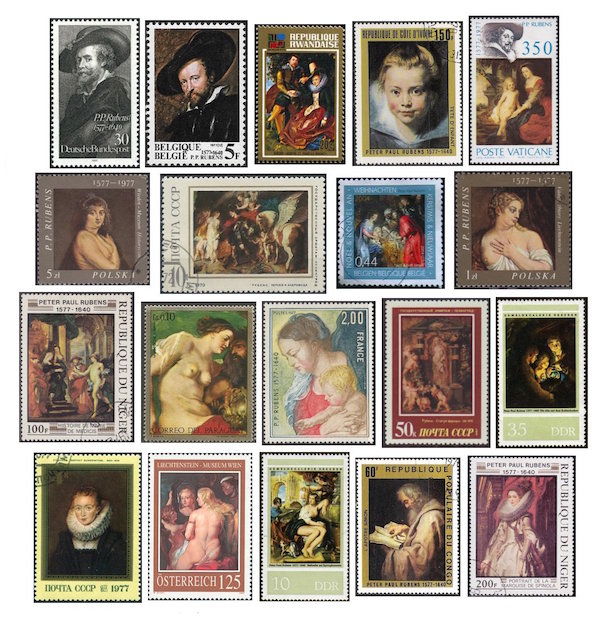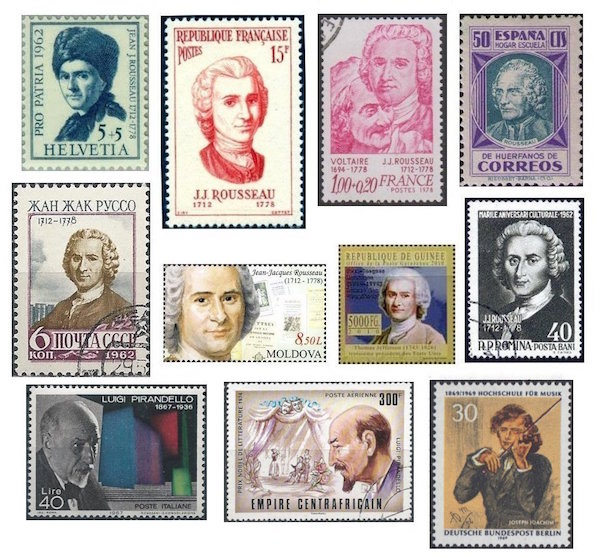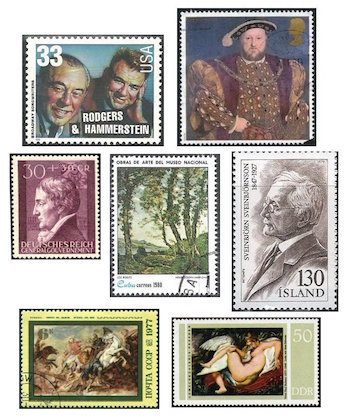The Arts on Stamps of the World — June 28
An Arts Fuse regular feature: the arts on stamps of the world.

By Doug Briscoe
Our stamps today commemorate the birthdays of Peter Paul Rubens, Jean-Jacques Rousseau, Luigi Pirandello, Joseph Joachim, Richard Rodgers, and Henry VIII, plus the usual gathering of lesser lights.
Well, I’m off on another voyage of discovery to sift through the legions of stamps for another giant in the art world, Peter Paul Rubens (28 June 1577 – 30 May 1640), and determine which of them earn a place in today’s overcrowded post. I usually associate Rubens with great gobs of pink flesh, but the stamps seem largely to have eschewed that effusively corporeal predilection of the master. Indeed it seems to me that most of the paintings chosen for these stamps from all over the world have focused on his less famous pieces.
Let’s begin. In the top row are three consecutive self-portraits: the one on the German stamp from 1623, the Belgian item from c1629, and, contrary to my above statement, one of Rubens’s best known pieces, Honeysuckle Bower, a self-portrait of the painter and his first wife Isabella, dated c1609, on a stamp from Rwanda. Then on a stamp from Côte d’Ivoire we see their daughter Clara Serena. Last on the top row is Holy Family With Parrot (“This parrot has gone to meet its maker.”) on a quatercentenary stamp from the Vatican.
Second row: detail from another favorite Rubens, the Portrait of [Rubens’s second wife] Hélène Fourment, or The Fur (c1638); Perseus and Andromeda (c1620); Adoration of the Magi (1617-18); and detail from Venus and Cupid.
From here on please refer to your handy illustrated catalogue.
III:1. The Negotiations at Angoulême (c1622-25), stamp from Niger;
III:2. The Four Parts of the World, detail (1612-14), Paraguay;
III:3. Virgin and Child, detail (between 1608 and 1621), France;
III:4. The Statue of Ceres (c1615), USSR;
III:5. Old Woman and Boy with Candles or Old Woman with a Basket of Coal (c1616-17), DDR;
IV:1. Portrait of a Lady in Waiting to the Infanta Isabella, USSR
IV:2. Venus shows up again (again admiring herself, and why not?) in Venus at a Mirror (c1615), Austria;
IV:3. Bathsheba at the Fountain (C1635), DDR;
IV:4. The Apostle Simon, Congo (PR)
IV:5. Portrait of Marchesa Brigida Spinola-Doria (1606), Niger.

Although Jean-Jacques Rousseau (1712 – 2 July 1778) is most celebrated as a philosopher and writer, he also composed a number of motets and seven operas, the best-known of which, Le devin du village, contains a duet (“Non, Colette n’est point trompeuse”) that Beethoven later arranged as the second of his 6 Songs of Various Nationalities, WoO 158c. Beside the stamp from Rousseau’s native Switzerland, I show two from France (the second pairing him with Voltaire) as well as examples from Spain, the USSR, Moldova, the Republic of Guinea, and Romania.
The coruscatingly brilliant and highly and emphatically opinionated critic (well, what critic isn’t?) Martin Seymour-Smith called Luigi Pirandello not only “one of the four greatest of modern playwrights” (the others being, in Seymour-Smith’s estimation, Brecht, Synge, and O’Neill), but also, unexpectedly, “the greatest short-story writer of the century [!].” Pirandello (28 June 1867 – 10 December 1936) did indeed write some 250 stories (from which he took the plots for 28 of his plays), but who, except Seymour-Smith, has read them, or for that matter any of the seven novels? Pirandello also wrote seven volumes of poetry, but Wikipedia says they were not translated into English until last year! Pirandello was awarded the Nobel Prize for Literature in 1934 and had the medal melted down to support the Fascist government’s aggression in Abyssinia. Apparently his political dalliance with Mussolini, however, was not deeply felt, and thus his reputation hasn’t caught much grief for it.
Joseph Joachim (1831 – 15 August 1907) was not only one of the preeminent violinists of the 19th century, but also a fine composer, as well as being the dedicatee of many important works by others, most notably the Brahms Violin Concerto and Double Concerto. His performance of the Beethoven Concerto, given in 1844 when he was not yet 13 (under Mendelssohn’s direction), was the catalyst for a reassessment of that work, which had for years been thought of as one of Beethoven’s less successful efforts (!). Joachim was the second person to perform the Mendelssohn e-minor Concerto and wrote three of his own. A great figure in music.
Richard Rodgers (June 28, 1902 – December 30, 1979) was the first EGOT winner, the first of the twelve individuals (so far) to have won Emmy, Grammy, Oscar, and Tony awards. He accomplished this feat in 1962. By an extraordinary coincidence, another member of the EGOT Club was also born on June 28—Mel Brooks, who turns 91 today! Brooks was the eighth, having achieved the milestone in 2001. Rodgers is also one of only two people to have earned the even more rarefied distinction of PEGOT, that is, piling the Pulitzer Prize Pelion on the EGOT Ossa. (The other one is Marvin Hamlisch.) Without going into too much detail (à la my Rubens compendium above), let it suffice to say that Rodgers won his Oscar in 1945 for Best Song, “It Might as Well Be Spring” from State Fair, and his Pulitzer for South Pacific (1950, in the Drama category). He was famously paired with two legendary lyricists, Lorenz Hart and Oscar Hammerstein II (whose birthday approaches). Rodgers wrote more than 900 songs and contributed to 43 Broadway musicals. I must also mention his work for the TV documentary series Victory at Sea (1952–53), though the lion’s share of the credit for that project likely belongs to Richard Rodney Bennett (his birthday was on the 15th inst., but no stamp), who took the dozen or so piano themes Rodgers provided and brilliantly expanded them into a massive 13-hour edifice. (Thanks to Steve Ledbetter for informing me of this.)

Today is the 526th anniversary of the birth of King Henry VIII (1491 – 28 January 1547), whose connection to music is more than just “I’m Ennery the Eighth I Am”; he played the lute, organ, and virginals (an early keyboard, precursor to the harpsichord; he also played upon an unspecified number of virgins) and composed songs and pieces for viols, as well as at least one sacred work, a 3-part motet on “Quam pulchra es”. His best known song is “Pastime with Good Company”.
The birth date of German garden designer and architect Johann Christian Schuch is unknown. He died on this date in 1813. Born in Dresden in 1752, he learned gardening from his father (court gardener for the House of Wettin) and painting and civil engineering at the Dresden Academy of Fine Arts. Thereafter he personally examined the gardens at Kew, the Grand Trianon, and Schönbrunn before eventually becoming overseer of the royal gardens for Polish King Stanisław II. He founded the first fruit tree nursery in Poland and, as a city planner, created two star-shaped “squares” in Warsaw. Alas, in the twentieth century Schuch’s home, a gift of the king, became the Warsaw headquarters of the Gestapo and the site of many horrific crimes. His stamp, too, is a relic of those days, as it was issued by the “General Gouvernement” authority in 1942.
French landscape painter Henri Harpignies (28 June 1819 – 28 August 1916) was born at Valenciennes and became a product of the Barbizon School. He was a close friend of Corot (birthday next month). The two friends traveled together to Italy in 1860, and Harpignies had his first noteworthy success at the following year’s Paris Salon. Trees figure very prominently in Harpignies’ work, as in The Oaks, seen on a Cuban stamp of 1980.

Icelandic composer Sveinbjörn Sveinbjörnsson (1847 – 23 February 1927) studied in Copenhagen and Leipzig and taught piano in Edinburgh until 1919. He was one of the founders of the Edinburgh Society of Musicians (1887) and toured as a pianist in the US and Canada. Most of his songs and some of his choral pieces are set to English texts. Grove Music Online tell us that his Royal Cantata of 1907 “was for a long time the most ambitious musical composition by an Icelander.” A hymn he wrote for the 1000th anniversary of the Norse settlement in Iceland became the Icelandic national anthem in 1944.
Since our third collage is on the small side, and because I had a few other Rubens images sitting around unused, and because I’m never satisfied and love to make more work for myself, here are a couple more Rubenses: The Lion Hunt (c1621), not to be confused with another painting of the same name nor with Tiger, Lion and Leopard Hunt (1616) and Leda and the Swan (1601-2).
Popular entertainers who share this June 28 birthday (besides the aforementioned Mel Brooks) are Gilda Radner (1946 – May 20, 1989) and Kathy Bates (1948), and American novelist Mark Helprin turns 70 today.
A graduate of the University of Massachusetts with a B.A. in English, Doug Briscoe worked in Boston classical music radio, at WCRB, WGBH, and WBUR, for about 25 years, beginning in 1977. He has the curious distinction of having succeeded Robert J. Lurtsema twice, first as host of WGBH’s weekday morning classical music program in 1993, then as host of the weekend program when Robert J.’s health failed in 2000. Doug also wrote liner notes for several of the late Gunther Schuller’s GM Recordings releases as well as program notes for the Boston Classical Orchestra. For the past few years he’s been posting a Facebook “blog” of classical music on stamps of the world, which has now been expanded to encompass all the arts for The Arts Fuse.
